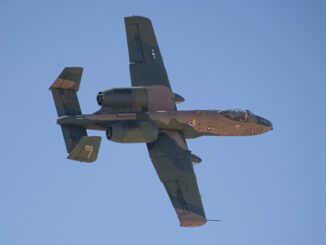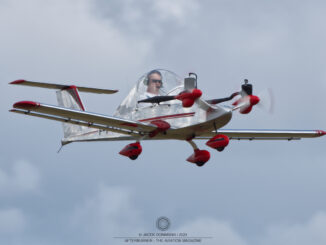 Formation of Pilatus aircraft: P-3-05 (c/n 497-46, formerly A-859 of the Swiss Air Force, D-EPCI), PC-12/47E (c/n 1627, OO-NLT) and PC-7-II ´Astra´ (c/n 615, N60LT), performing a flying display over Kleine-Brogel air base during Spotter day 2017; Kleine-Brogel, September 2017.
Formation of Pilatus aircraft: P-3-05 (c/n 497-46, formerly A-859 of the Swiss Air Force, D-EPCI), PC-12/47E (c/n 1627, OO-NLT) and PC-7-II ´Astra´ (c/n 615, N60LT), performing a flying display over Kleine-Brogel air base during Spotter day 2017; Kleine-Brogel, September 2017.
The Pilatus P-3 represents the second generation of the Swiss-made military training aircraft that succeeded its predecessor – the P-2 trainer – in the early 1950s. The aircraft performed its maiden flight on 3rd September 1953 and was used by the Swiss Air Force during the next two decades. A few examples however were still in operational service yet until the 1990s, being used as liaison aircraft.
Nowadays, several decommissioned P-3 aeroplanes are still used by civilian operators, as well as the P3 Flyers aerobatic group. The full history of development and service of that aircraft was described in more details within our Photo of the Week series, in November of 2022.
The Pilatus PC-12 is a small passenger and cargo aircraft developed by the Pilatus company in the early 1990s. The aeroplane performed its maiden flight on 31st May 1991 and received its type certificate in 1994.
The PC-12 was designed as high-performance utility aircraft, featuring pressurized cabin, large cargo door, ability to operate from rough, unpaved and relatively short runways and trailing-arm undercarriage. The aeroplane is powered by single turboprop engine made by Pratt & Whitney Canada – PT6A-67B or PT-6E-67P.
In 2008, the Pilatus company introduced an upgraded variant of the aircraft, officially designated PC-12/47E but usually marketed as PC-12 NG (next generation). In 2019, it was followed by another modernized version, PC-12NGX. Until today, there were more than 1,800 examples of that aeroplane manufactured, making the PC-12 one of the most popular single-engine, turboprop aircraft in the world.
The Pilatus PC-7 was developed in the mid-1960s from the aforementioned P-3 trainer. The aircraft featured new, turboprop engine, bubble-shaped canopy and redeveloped wings construction. Although the prototype performed its first flight already on 12th April 1966, the project was frozen for several years and serial production of the PC-7 commenced only in late 1977.
Nevertheless, the PC-7 achieved broad commercial success and was acquired by approximately twenty air forces all over the world and built in more than six hundred examples.
The aeroplane was manufactured in three main variants: the initial PC-7 Turbo-Trainer powered by PT-6A-25A engine; PC-7 Mark II, a variant originally developed for the South African Air Force and being a hybrid of the PC-7 and PC-9 trainers, that version is also commonly called the ´Astra´; NCPC-7 modernized variant of the initial Turbo-Trainers for the Swiss Air Force, featuring IFR avionics suite and glass cockpit (NC stands for New Cockpit).



